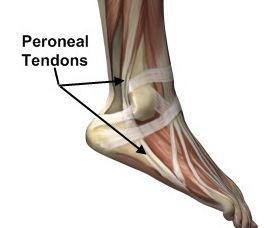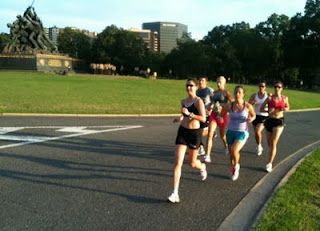Warning Signs
About a week ago, as I was laying in bed before going to sleep, I noticed something very faint in a small area of my foot. When I went to go feel for the area, I immediately recognized it as the same area that I used to massage when I had Peroneal Tendonitis back in August of 2009. That was a horrible injury. I ended up having to take five weeks off of running and I missed my fall marathon because of it. I didn't know about pool running back then so when I returned to running, my fitness had gone out the window.
I wouldn't describe what I felt last week as a pain-- more of just a sensation. Throughout the week I continued to run, but I iced the area just to be on the safe side. I didn't feel a thing while running or walking. But when I was completely at rest and trying to fall asleep, there was that nagging little feeling in my foot.
 |
| My Peroneus Longus is Irritated |
Emotional Roller Coaster & Denial
Friday can best be described as an emotional roller coaster. For 15 minutes, the area would be 100% silent, but then 15 minutes later, I'd feel something again. I'd walk around without any sensation in the area at all, but then a short while later I would feel something while walking. I kept going back and forth on whether or not I should do my 18-miler the next day. Eventually, I shook myself out of denial: If you are wavering this much, the answer is no long run. How much would it suck to truly injure myself on a long run when my body was giving me warning signs of a previous injury? An injury that sidelined me for five weeks!!!!
I made the sensible decision to spend 2 hours and 40 minutes pool running. Thankfully, I had the company of some of my CAR teammates. Ironically, Tara and I had planned to meet at 6:00 that day to run 18 miles, and when Saturday rolled around, we were both pool-bound. Even though my foot didn't actually hurt-- I definitely felt something in that peroneal tendon attachment area and I was taking it seriously. No denial!
Detective Work
My most important question was why I was getting this injury. My mileage increase has been extremely gradual and I even had a "cutback" week two weeks ago. I'm only running four days a week, as opposed to the six I used to run during typical marathon training cycles. So it's not overtraining. My first question in my sleuthing: what has changed in my training recently?
I can think of three things: core work, hills, no foot slapping. At first, I thought that the side bridges (core work) were the culprit. Putting weight right there on the side of my foot might have been irritating the area. Good theory, but I ultimately didn't think it was the true culprit. I didn't think it was the hills because I only do them once a week, and the hill isn't that steep. So. . . foot slapping?
When I went on my first long run with CAR, my coach told me that I was a "foot slapper" and that I needed to be lighter on my feet to prevent injury and be more efficient. Foot slapping is when the ball of the foot hits the ground and makes a slapping noise, rather than being quiet. When I asked him how to not do it, he told me to just focus on not doing it. And so I did. I found it easy to correct and since that day in late June, there was no more foot slapping.
So, foot slapping was one piece of the puzzle. Question number two: what causes peroneal tendonitis in runners? I consulted Dr. Google and found that a strained peroneus longus muscle is often the culprit. As soon I read that, I remembered back to earlier in the week when I noticed my outer lower leg was sore. This just felt like the standard muscle ache so I didn't pay any special attention to it at all. But suddenly the pieces were coming together. I massaged around the peroneous longus muscle and voila: a tight and tender area.
Question #3: Why is my peroneus longus muscle strained? To answer this one, I had to figure out which motion stresses that muscle. The answer was easy-- plantar flexation of the foot. This would explain why my foot doesn't hurt at all when I walk, but I definitely feel something while driving. My drive to and from the pool hurt my foot more than anything else because my foot was in a flexed position the entire time.
So far, I knew that plantar flexation while running caused me to strain my peroneus longus muscle, which resulted in mild tendon inflammation near the foot-- felt primarily when driving. And I knew that I changed my gait to avoid foot slapping. Well, what muscle do you use to restrain that forefoot from coming down hard? The peroneous longus!!!! I realized that I was flexing my foot ever so slightly to keep it from slapping down, and in doing so, strained the peroneous longus muscle.
I can't be 100% sure that my foot issue was caused by this, but it makes a lot of sense. Changes in gait often lead to injuries, even if they are for the better.
The Solution
I plan to do strengthening exercises for the peroneous longus muscle as well as stretching and massage. I am also wearing my CEP compression sleeve to help speed recovery. I'm icing my foot A LOT. I also scheduled two ART (Active Release Technique) sessions with the sports doctor who did my gait analysis.
My coach told me to wait until my tendon felt 100% to return to running, and I plan to take that advice. My foot already feels much better today than it did yesterday. I have no pain with walking and I only feel it while driving or when pointing and flexing my foot. And even then, I would give it a 1.5 out of 10 on the pain scale. It's very minor and had I not experienced this injury in the past, I wouldn't be reacting this way. The earliest I see myself running again is Thursday (which would be six full days off) and that's only if I am pain free. My hope is to be able to run 18 miles on Saturday, but I won't do it unless I'm completely free and clear of any foot sensations.
Some of the best running advice I ever received was "sacrifice a day of training to save a week, sacrifice a week to save a month, sacrifice a month to save a year." So I am sacrificing a week to save a month. I'll continue to do workouts in the pool (today I did 40 minutes of pool running plus 1000yd swim) and hopefully get to the starting line of my marathon both healthy and well trained.








